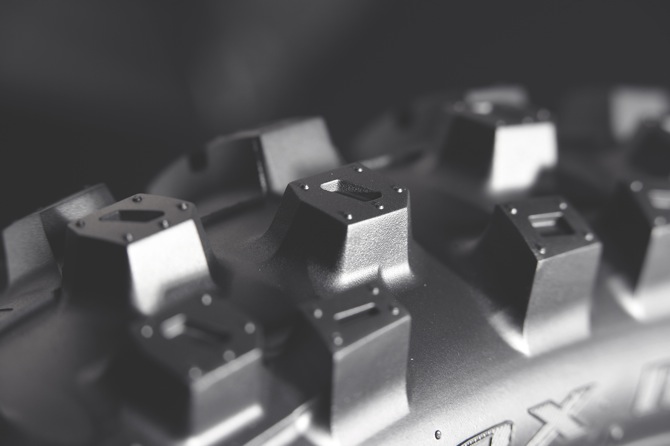CHOOSING THE CORRECT AIR PRESSURE FOR YOUR SNEAKERS


Where should you start with your bike’s tire pressure? The best ballpark tire-pressure setting is 12 psi front and 12 psi rear. It is important to know your tire pressure down to the exact pound. Why? A 1-pound increase or decrease in pressure is almost a 10-percent adjustment. The change in casing stiffness, knob footprint and traction is exponential.
Getting a good tire gauge is essential to maximizing tire performance. If you can’t afford a good tire gauge, make sure that you use the same cheap gauge every time?that way you can find the best tire pressure by trial and error. If you borrow tire gauges from friends, your tire pressure could be all over the map with the variations in each gauge. The best tire gauges are 0 to 60 psi gauges. You might think that a 0 to 30 psi gauge would be more accurate, but that is only until you put it on a new tube to pop the bead and pop the gauge instead. Digital gauges tend to be less trustworthy than those with a dial scale. Whatever gauge you use, consistently check it against your friend’s, the race shop’s or an auto tire center’s to make sure it isn’t way off.
Air pressure should be checked just before practice and just before motos. Air pressure increases as the air inside the tire gets warmer. Plus, tire pressure increases as the ambient temperature goes up, thus the tire pressure you set in the garage last night could be 4 or 5 psi higher by the time your moto rolls around the next day.
Whenever a tire is spinning, the rubber is getting hotter — because of friction between the tire and tube, the tire and ground, and the tire and itself. The increase in tire pressure varies with a wide variety of circumstances. For example, tire pressure increases more in the rear than in the front. Tire pressure increases more on a hot day than on a cold day. Tire pressure increases more on a blue-grooved track than on a loamy one.
How much does tire pressure increase during a moto? Tire pressure increases as much as 6 pounds in the rear tire and in the front by as much as 3. This makes a big difference in the way a bike feels and handles.
MXA’S TIRE-PRESSURE BASICS

Tire pressure may be seen as a “set it and forget it” deal, but it is far from it. Tire pressure is constantly changing?even if you don’t touch it. There are lots of tire tricks. Here are some of the most common.
Nitrogen: Nitrogen has a larger molecule, which means it doesn’t leak out through the pores in the rubber as quickly as air. Additionally, nitrogen doesn’t have any moisture content, so when it is heated, it doesn’t expand as much. That’s not to say that a tire filled with nitrogen won’t increase in pressure, but it does cut the rise in psi almost in half.
Rim clean: The sidewalls of a tire roll over the edge of the rim as the bike is being ridden. As the tire flexes, the sidewalls actually scrape the edge of the rim clean. You can measure the width of the clean part of the rim to determine whether you have too much or too little air pressure. Aim for 4mm of polished rim clean.
Too much air: Too much air in your tires will show up as a lack of grip and excessive wheelspin. A front tire that slides around, won’t stick in turns or deflects over braking bumps has too much air. If the pressure is too high, there won’t be any rim clean.
Too little air: A bike with too little air will wallow through the bumps. Similar to too much pressure, a soft front tire also won’t stick in the turns because of knob roll-over. If the pressure is too low, there will be more than 4mm of rim clean.
Mud strategy: When it’s muddy, you can lower the rear tire pressure to 10 psi or less. But, if the mud isn’t very deep and the speeds are still high, you won’t be able to drop the pressure for fear of flatting. If the mud is so tacky that you’re fighting to keep the front end down, you might think of raising the pressure in the back so the tire will break loose easier.
Rock strategy: Rocky tracks require special prep. (1) Raise tire pressure on rocky tracks. (2) Many professional mechanics wrap a tube with another tube to avoid pinch flats. (3) Run tire pressures in the neighborhood of 14 psi front and 13 psi rear. (4) Consider a bib mousse in the rear.
Warming your tire: Spinning your tire to heat it up before the start must be done within 45 seconds of the gate falling. A tire that isn’t in motion will cool down quickly.




Comments are closed.